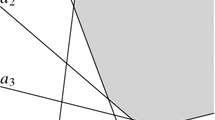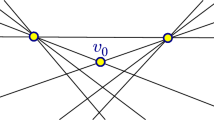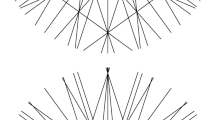Abstract
Questions about lines in space arise frequently as subproblems in three-dimensional computational geometry. In this paper we study a number of fundamental combinatorial and algorithmic problems involving arrangements ofn lines in three-dimensional space. Our main results include:
-
1.
A tight Θ(n 2) bound on the maximum combinatorial description complexity of the set of all oriented lines that have specified orientations relative to then given lines.
-
2.
A similar bound of Θ(n 3) for the complexity of the set of all lines passing above then given lines.
-
3.
A preprocessing procedure usingO(n 2+ɛ) time and storage, for anyε>0, that builds a structure supportingO(logn)-time queries for testing if a line lies above all the given lines.
-
4.
An algorithm that tests the “towering property” inO(n 2+ɛ) time, for anyε>0; don given red lines lie all aboven given blue lines?
The tools used to obtain these and other results include Plücker coordinates for lines in space andε-nets for various geometric range spaces.
Similar content being viewed by others
References
P. Agarwal, Geometric partitioning and its applications, inDiscrete and Computational Geometry: Papers from the DIMACS Special Year, American Mathematical Society, Providence, RI, 1991.
B. Aronov, M. Pellegrini, and M. Sharir, On the zone of a surface in a hyperplane arrangement, In preparation. See alsoProc. 2nd WADS Workshop, 1991, Lecture Notes in Computer Science, Vol. 519, Springer-Verlag, Berlin, pp. 13–19, for an early version by two of the authors.
O. Bottema and B. Roth,Theoretical Kinematics, Dover, New York, 1990.
B. Chazelle, H. Edelsbrunner, L. Guibas, R. Pollack, R. Seidel, M. Sharir, and J. Snoeyink, Counting and cutting cycles of lines and line segments in space,Proc. 31st IEEE Symp. on Foundations of Computer Science, 1990, pp. 242–251.
B. Chazelle, H. Edelsbrunner, L. Guibas, and M. Sharir, Algorithms for bichromatic line segment problems and polyhedral terrains, In preparation. An earlier version of this paper, combined with the current paper, has appeared inProc. 21st ACM Symp. on Theory of Computing, 1989, pp. 382–393.
B. Chazelle, H. Edelsbrunner, L. Guibas, and M. Sharir, A singly-exponential stratification scheme for real semi-algebraic varieties and its applications,Proc. 16th ICALP Colloq., Lectures Notes in Computer Science, Vol. 372, Springer-Verlag, Berlin, 1989, pp. 179–193.
K. Clarkson, H. Edelsbrunner, L. Guibas, M. Sharir, and E. Welzl, Combinatorial complexity bounds for arrangements of curves and surfaces,Proc. 29th IEEE Symp. on Foundations of Computer Science, 1988, pp. 568–579.
B. Chazelle and J. Friedman, A deterministic view of random sampling and its use in geometry,Combinatorica,10 (1990), 229–249.
B. Chazelle, An optimal convex hull algorithm and new results on cuttings,Proc. 32nd Symp. on Foundations of Computer Science, 1991, pp. 29–38.
K. Clarkson, New applications of random sampling in computational geometry,Discrete Comput. Geom.,2 (1987), 195–222.
K. Clarkson, A probabilistic algorithm for the post office problem,Proc. 17th ACM Symp. on Theory of Computing, 1985, pp. 175–184.
K. Clarkson, Applications of random sampling in computational geometry,Discrete Comput. Geom.,4 (1989), 387–421.
H. Edelsbrunner,Algorithms in Combinatorial Geometry, Springer-Verlag, Heidelberg, 1987.
H. Edelsbrunner, L. Guibas, and M. Sharir, The complexity of many faces in arrangements of lines and of segments,Proc. 4th ACM Symp. on Computational Geometry, 1988, pp. 44–55.
H. Edelsbrunner, L. Guibas, and M. Sharir, The complexity of many faces in arrangements of planes and related problems,Discrete Comput. Geom.,5 (1990), 197–216.
G. Fano and A. Terracini,Lezioni di Geometria Analitica e Proiettiva, Paravia, 1939.
Z. Gigus, J. Canny, and R. Seidel, Efficiently computing and representing aspect graphs of polyhedral objects, Technical Report UCB/CSD 88/432, Univesrity of California at Berkeley, August 1988.
W. Hodge and D. Pedoe,Methods of Algebraic Geometry, Cambridge University Press, Cambridge, 1952.
K. Hunt,Kinematic Geometry of Mechanisms, Oxford, 1990.
D. Haussler and E. Welzl, Epsilon nets and simplex range searching,Discrete Comput. Geom.,2 (1987), 127–151.
A. Inselberg,N-dimensional graphics. Part I —lines and hyperplanes. Scientific Center Report G320-2711, IBM, Los Angeles, CA, 1981.
C. M. Jessop,A Treatise on the Line Complex, Chelsea, New York, 1969.
J. Matoušek, Construction ofε-nets,Discrete Comput. Geom.,5 (1990), 427–448.
J. Matoušek, Cutting hyperplane arrangements,Discrete Comput. Geom.,6 (1991), 385–406.
J. Matoušek, Approximations and optimal geometric divide-and-conquer,Proc. 23rd Annual ACM Symp. on Theory of Computing, 1991, pp. 506–511.
M. McKenna, Arrangements of lines in 3-space: a data structure with applications, Ph.D. Dissertation, Johns Hopkins University, 1989.
J. Milnor. On the Betti numbers of real varieties,Proc. Amer. Math. Soc.,15 (1964), 275–280.
M. McKenna and J. O'Rourke, Arrangements of lines in 3-space: a data structure with applications,Proc. 4th ACM Symp. on Computational Geometry, 1988, pp. 371–380.
M. Paterson, Personal communication.
W. H. Plantinga and C. R. Dyer, An algorithm for constructing the aspect graph,Proc. 27th IEEE Symp. on Foundations of Computer Science, 1986, pp. 123–131.
J. Plücker, On a new geometry of space,Philos. Trans. Roy. Soc. London,155 (1865), 725–791.
J. Pach, R. Pollack, and E. Welzl, Weaving patterns of lines and line segments,Proc. 1st SIGAL Symp., Lecture Notes in Computer Science, Vol. 450, Springer-Verlag, Berlin, 1990, pp. 437–446.
R. Seidel, Constructing higher dimensional convex hulls at logarithmic cost per face,Proc. 18th ACM Symp. on Theory of Computing, 1986, pp. 404–413.
M. Sharir, Onk-sets in arrangements of curves and surfaces,Discrete Comput. Geom.,6 (1991), 593–613.
M. Sharir, On joints in arrangements of lines in space and related problems, In preparation.
D. M. Y. Sommerville,Analytical Geometry of Three Dimensions, Springer-Verlag, Heidelberg, 1987.
J. Stolfi,Oriented Projective Geometry, Academic Press, New York, 1991.
Author information
Authors and Affiliations
Additional information
Communicated by D. P. Dobkin.
Work on this paper by Bernard Chazelle has been supported by NSF Grant CCR-87-00917. Work on this paper by Herbert Edelsbrunner has been supported by NSF Grant CCR-87-14565. Work on this paper by Leonidas Guibas has been supported by grants from the Mitsubishi and Toshiba Corporations. Work on this paper by Micha Sharir has been supported by ONR Grant N00014-87-K-0129, by NSF Grants DCR-83-20085 and CCR-89-01484, and by grants from the U.S.-Israeli Binational Science Foundation, the NCRD — the Israeli National Council for Research and Development, and the EMET Fund of the Israeli Academy of Sciences.
Rights and permissions
About this article
Cite this article
Chazelle, B., Edelsbrunner, H., Guibas, L.J. et al. Lines in space: Combinatorics and algorithms. Algorithmica 15, 428–447 (1996). https://doi.org/10.1007/BF01955043
Received:
Revised:
Issue Date:
DOI: https://doi.org/10.1007/BF01955043




